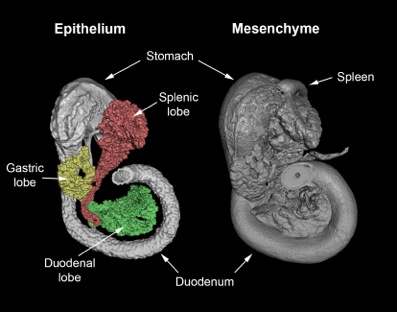Pancreas development
Ulf Ahlgren, Professor of Molecular Medicine, Umeå Centre for Molecular Medicine, Umeå University, Building 6M, S-901 87, Umeå, Sweden www.umu.seThe pancreas starts to form as a dorsal and ventral evagination of the foregut epithelium, resulting in the formation of a dorsal and ventral pancreatic bud. At E10.5, these buds are well established and visible to the naked eye. During subsequent development, the pancreatic epithelium will grow, branch and differentiate as it invades the surrounding mesenchyme. As the stomach and duodenum rotate during development the dorsal and ventral anlagen will become positioned on the same side to eventually fuse. During this process, the pancreatic buds will develop into the distinct anatomical parts of the adult organ, i.e. the splenic, duodenal and gastric pancreatic lobe. The latter is formed by perpendicular growth from the dorsal (splenic) anlagen. The movies on this page illustrates this process between E10.5 and E17.5 and are generated by optical projection tomography (OPT) imaging of dissected mid gut regions enclosing the developing duodenum, stomach, pancreas and spleen. The reconstruction of the endodermal component (including the pancreas) is based on the signal from E-cadherin labeling whereas the mesenchymal component (including the spleen) is based on endogenous tissue fluorescence. For details please see chapter 6 of Kaufman's Atlas of Mouse Development Supplement (2015) & Hörnblad et al., PLoS One 2011.

Figure caption:
In the movies, the lobular compartments of the pancreatic epithelium are pseudo colored: red (splenic lobe), green (duodenal lobe) and yellow (gastric lobe) respectively, here illustrated at E15.5.
Movie | Download (mpg format) | Description | e10.5 High Res movie (6.79MB) |
Pancreas morphogenesis is initiated as two opposed dorsal and ventral domains of the foregut epithelium posterior to the developing stomach that evaginates into the surrounding mesenchyme. At e10.5, these initial evaginations have developed into well-defined ventral and dorsal pancreatic buds clearly visible to the naked eye. At this stage the pancreatic mesenchyme and the mesenchyme of the presumptive spleen is tightly connected to the stomach mesenchyme and it is difficult to morphologically differentiate between one and the other. |
|---|---|---|
e11.5 High Res movie (8.32MB) |
At this stage the splenic mesenchyme has started to condense and is morphologically recognizable in the mesenchyme covering the dorsal aspect of the pancreas. The pancreatic epithelium has expanded into the mesenchyme and the very first signs of morphogenetic movements bringing the two anlagen together can bee seen as the pancreatic buds start to tilt slightly in opposite directions. |
|
e12.5 High Res movie (11.23MB) |
As the stomach and duodenum rotate during development the dorsal and ventral pancreas are being positioned on the same side of the gut. The spleen anlage is morphologically distinct and starts to become separated from the dorsal pancreatic mesenchyme. |
|
e13.5 High Res movie (12.60MB) |
At this stage, the pancreatic buds have been brought to the same side of the developing gut and fusion of the dorsal and ventral pancreatic ducts occurs at some distance from the duodenum. The lateral growth from the stalk of the dorsal pancreatic epithelium into a mesenchymal domain overlying the pyloric sphincter initiates the formation of the gastric lobe of the pancreas. The splenic mesenchyme is now completely separated from the dorsal pancreatic mesenchyme. |
|
e14.5 High Res movie (13.79MB) |
At this stage the gastric lobe is present as a clearly distinguishable epithelial domain overlying the pyloric sphincter. The overall ratio of mesenchyme to epithelium in the pancreas is gradually decreasing. |
|
e15.5 High Res movie (25.14MB) |
From this stage onwards the gastric lobe constitutes more than 10% of the overall pancreatic epithelial volume and covers also the pyloric antrum. |
|
e17.5 High Res movie (34.86MB) |
At this stage, the entire pancreas, including the gastric lobe, has essentially adopted its adult position and shape. |




